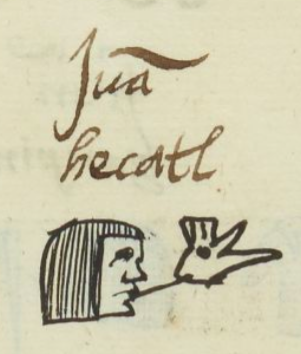Ecatl (MH498v)
This black-line drawing of the simplex glyph for the personal name Ecatl (perhaps meaning "Air" or "Breath," but pictured as Ehecatl, the divine force of wind) is attested as a man's name. It shows what appears to be a bird head in profile, facing toward the viewer's right. The beak is open. Above the upper part of the beak is a protrusion that is squared off. It has two vertical lines dividing it somewhat. The visible eye appears to be open.
Stephanie Wood
A great many glyphs in this collection start with Eca- when Eheca- might be expected, given the iconography. The black line (face paint?) across this man's face is a diagnostic for Ehecatl, the divine force or deity of the wind. The lack of reduplication of the first syllable in the man's name by itself is not unusual. Ecatl can mean air or breath, while ehecatl is the usual way of writing wind. Wind has a notable importance in Nahua religion, often preceding the rain that was so essential for temporal agriculture. Ehecatl was a day sign in the 260-day divinatory calendar (tonalpohualli), which meant it ended up as a personal name for many people.
The shortening of the name from "Ehecatl" to "Ecatl" could have been a strategic effort to disguise the deity name, possibly a response to the edict of 1540 prohibiting the naming of Nahua children after deities. [See Norma Angélica Castilla Palma, "Las huellas del oficio y lo sagrado en los nombres nahuas de familias y barrios de Cholula," Dimensión Antropológica v. 65 (sept.-dic. 2015), 186.] Castilla also mentions how there were pressures to stop using names from the tonalpohualli, and this led to the dropping of the number that would have accompanied the day name. Such a number is absent here. So the whole result is a lessening of the sacred aspects, perhaps a type of resistance to colonialism.
The second sun on the Aztec sun stone has a much more elaborate representation of the wind; this epoch was ruled by Quetzalcoatl. The second sun was destroyed by hurricanes and the people were turned into monkeys.
For other images of Ehecatl and more information about his shape and that of Quetzalcoatl, see Mexicolore. One of the pre-Columbian statues devoted to the wind gives him a monkey's body but the same buccal mask (large point above the mouth or beak) as we see in this glyph. A type of hummingbird has the name ecahuitzilin, which shows another possible connection between the divine force associated with the wind and birds. But the ecahuitzilin seems to have coloring that is different from the visual in this glyph.
Gabrielle Vail and Christine Hernández (Re-Creating Primordial Time, 2013, ) describe Ehecatl as the wind aspect of Quetzalcoatl, and they note that Ehecatl "wears a buccal (duck) mask through which to blow wind." That the "beak" may have been perceived as a blowing device is supported by the glyph for Pitztli (below).
Stephanie Wood
Juā
hecatl
Juan Ecatl (or Juan Ehecatl?)
Stephanie Wood
1560
Jeff Haskett-Wood
wind, viento, deidades, deities, divine forces, fuerzas divinas, máscaras, masks, aliento, aire, nombres de hombres, ave, aves, pájaro, pájaros, pluma, plumas, animals, animales

eheca(tl)/Ehecatl, wind, or the divine force or spirit of the wind, https://nahuatl.wired-humanities.org/content/ehecatl
eca(tl), breath air, https://nahuatl.wired-humanities.org/content/ecatl
La Fuerza Divina del Viento
Stephanie Wood
Matrícula de Huexotzinco, folio 498v, World Digital Library, https://www.loc.gov/resource/gdcwdl.wdl_15282/?sp=76&st=image
This manuscript is hosted by the Library of Congress and the World Digital Library; used here with the Creative Commons, “Attribution-NonCommercial-ShareAlike 3.0 License” (CC-BY-NC-SAq 3.0).










